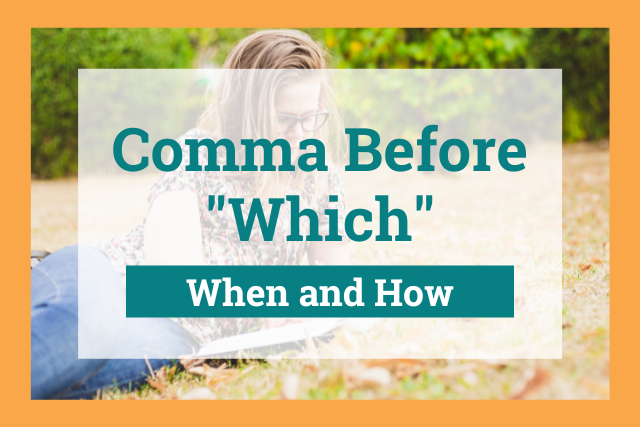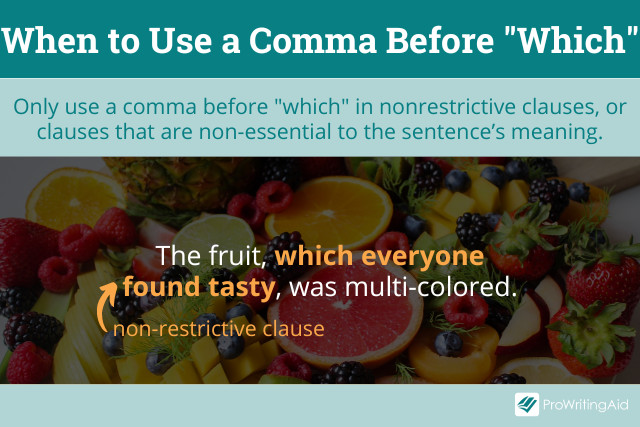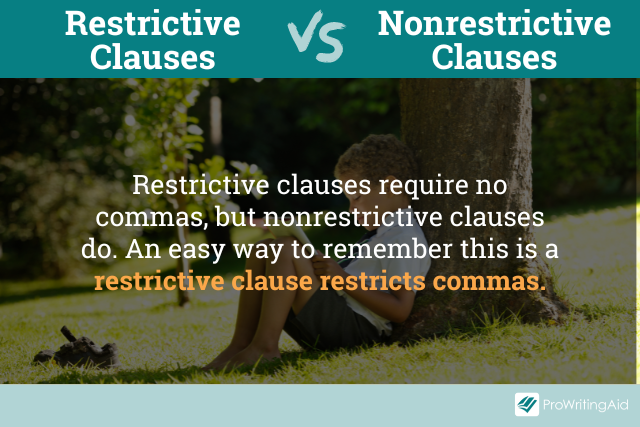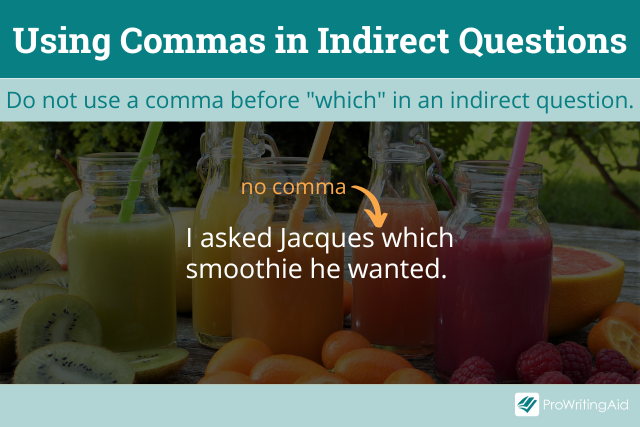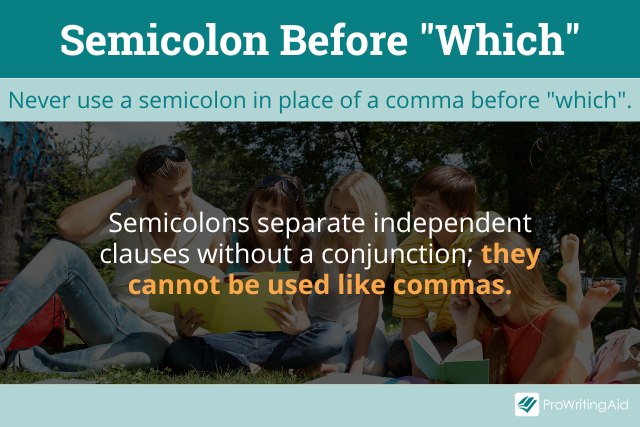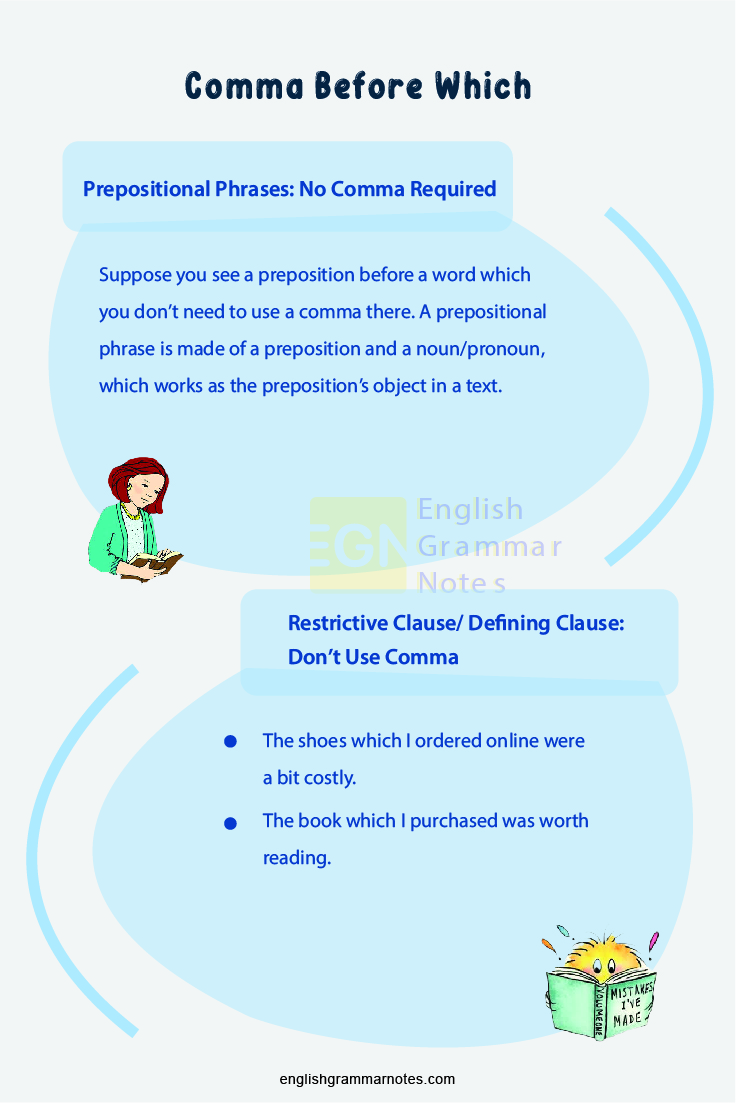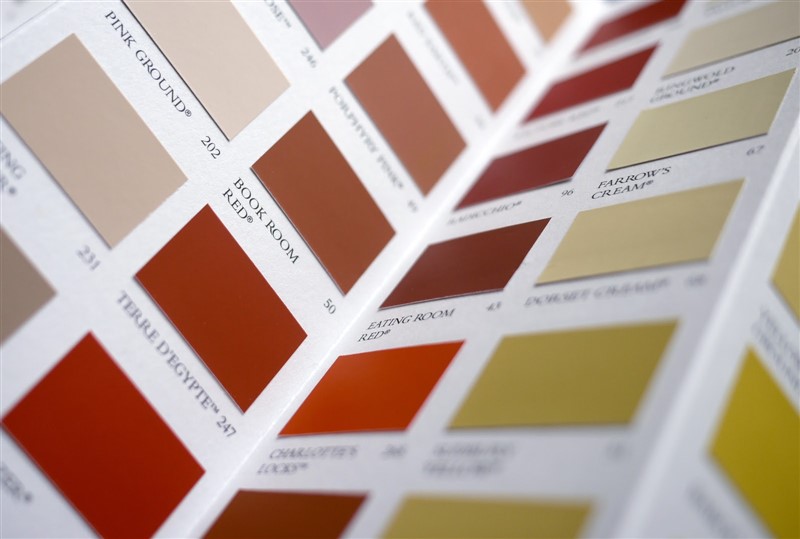Main Takeaways:
- Place a comma beforewhich when which precedes a nonrestrictive clause.
- A nonrestrictive clause is a phrase that adds non-essential information to a sentence without changing the overall meaning.
- Don’t place a commabeforewhich when which is part of a prepositional phrase.
- Don’t use a commabefore which when it’s used to pose an indirect question.
- We use which with nonrestrictive clauses, while we use that with restrictive clauses.
- When used with a restrictive clause, you don’t need to put a commabeforethat.
- Restrictive clauses function as identifiers. Removing a restrictive clause from a sentence changes the sentence’s meaning.
Whether to use a comma before or afterwhich in a sentence is a dilemma that many people face when writing. This grammar guide will teach you when you should and shouldn’t place a comma before which.
When it comes to grammatical conundrums, commas are often the culprit. Thankfully, learning when to use a comma before and afterwhich is actually pretty easy when you follow several simple rules.
When Should You Use a Comma Before Which?
Simply put, you should use a comma beforewhich when it precedes a nonrestrictive modifying clause. A nonrestrictive modifying clause is a phrase that adds nonessential information to a sentence without altering its meaning. It’s normally set off from the rest of a sentence with commas.
In this example, the phrase “which can be difficult to use correctly” is the nonrestrictive modifying clause. It modifies the noun comma, letting us know that commas can be challenging. Without it, however, the primary meaning of the sentence would remain intact.
In the example above, the sentence is correctly punctuated with a comma beforewhich. Another comma, placed after “correctly,” sets the phrase completely apart from the rest of the sentence. This is typical of nonrestrictive clauses.
Note: Nonrestrictive modifying clauses are also known as nonessential clauses or parenthetical expressions.
Should Which Always Be Preceded By a Comma?
The quick answer to this question is no. A comma should always precede which when it introduces a nonrestrictive clause. Otherwise, don’t place a comma prior to which.
There are several other ways that which can be used in a sentence. None of the following ways require a comma before which.
1. When Which Is Used in Prepositional Phrases.
Sometimes which forms part of a prepositional phrase. A prepositional phrase includes a preposition and a noun or pronoun that serves as the object of the preposition. It may also include adjectives that modify the object.
When which appears in prepositional phrases, it’s typically paired with a preposition.
- in which
- on which
- during which
- after which
- from which
When used this way, you don’t need a comma before the which.
2. When Which Forms a Question
Since sentences never begin with commas, it should go without saying that you don’t need one before which when it starts a sentence.
After all, it would look pretty strange if it was written as:
There is, however, another potential scenario when which forms a question. That’s the indirect question. In this scenario, a question is implied rather than asked outright. There is no question mark at the end of the sentence in indirect questions (unless they’re embedded in another question).
Essentially, both examples are asking about what items are on sale. One asks directly, while the other poses the question indirectly.
Comma After Which
Some grammarians believe that a comma can be used after which for reasons of style.
You’ll notice here that by adding a comma after the which, you end up with commas before and after it. This can lead to a choppy sentence. In this case, rephrasing may be the better option.
That vs. Which: Picking the Right Word
When learning how to punctuate a sentence using the word which, it’s important to understand when which isn’t the right word at all.
One Rule to Guide Them All
It’s easy to get tangled up choosing between that and which, but there’s a simple rule for picking the right word. That is used with restrictive clauses. Which is used with nonrestrictive clauses.
Restrictive Clauses
To simplify, restrictive clauses provide essential descriptive information about the noun they modify. They function as identifiers, essentially narrowing things down. They can’t be removed from a sentence without altering the meaning.
The restrictive clause in this sentence, “that are well-trained,” modifies the noun—in this case, dogs. This clause narrows it down to a specific category of dogs: well-trained dogs. You can’t remove the clause without altering the sentence’s essential meaning. That makes it a restrictive clause.
When used this way, there’s no need to place a comma before that.
Nonrestrictive Clauses
As discussed earlier, nonrestrictive clauses add non-essential information to a sentence. Unlike a restrictive clause, a nonrestrictive clause doesn’t alter the main meaning of the sentence.
The nonrestrictive clause, “which Amy got from a rescue,” adds interesting information and context to the noun, dog. However, you can remove the clause from the sentence without changing the meaning.
No Comma Drama
Punctuating sentences can be challenging, and even experienced writers and grammarians often struggle with proper placement of commas. Remembering simple rules of usage can take the drama out of comma placement, letting the meaning of your sentences come through loud and clear.
Quick Comma Before Which Grammar Quiz
Comma Before Which Question #1
A. Use a comma before «which» only when it precedes a nonrestrictive clause.
B. Always use a comma before «which.»
Correct!
Wrong!
The answer is B. You should use a comma before “which” when it precedes a nonrestrictive clause.
Comma Which Question #2
A. Basketball is a sport that I enjoy watching.
B. Basketball is a sport which I enjoy watching.
Correct!
Wrong!
The answer is A. «That» is used with restrictive clauses, while «which» is used with nonrestrictive clauses.
Comma Before Which Question #3
A. Restrictive clauses are essential to the sentence’s meaning.
B. Restrictive clauses add non-essential information to a sentence.
Correct!
Wrong!
The answer is A. Restrictive clauses can’t be removed from a sentence without altering the meaning.
Correct!
Wrong!
The answer is FALSE. When «which» appears in prepositional phrases, you don’t need a comma before the «which.»
Comma Before Which
Almost got it! Review the article and try again
Read More: How To Use Commas In Your Writing
Comma rules are confusing because they change depending on the situation. You might be unsure whether to use a comma before which since the answer is different depending on the sentence.
In general, the rule is to only use a comma before which when which is part of a non-restrictive clause.
You can always double-check your comma usage with our free grammar checker. But let’s take a closer look at the rules about commas before which, so you can avoid making a mistake in the first place.
Do You Put a Comma Before Which?
There are three main situations when you might use which in a sentence:
- In dependent clauses
- In questions
- In prepositional phrases
We’ll discuss each of these usages and whether to use a comma before which in them.
Comma Before Which in Non-Restrictive Clauses
A dependent clause can be classified as either a restrictive clause or a non-restrictive clause. To know when to use a comma before which, you need to understand the difference between these two types of clauses.
A restrictive clause is also called a defining clause. These clauses add crucial information to a sentence. If you remove a restrictive or defining clause, you change the sentence’s meaning.
For restrictive clauses, do not use a comma before which or after the clause. Here’s an example:
Correct: The house which we toured on Saturday sold above the asking price.
Incorrect: The house, which we toured on Saturday, sold above the asking price.
Incorrect: The house, which we toured on Saturday sold above the asking price
Incorrect: The house which we toured on Saturday, sold above the asking price.
The “which clause” is essential to the sentence. Without it, we don’t know which house we’re talking about. That makes it restrictive.
However, we use a comma before which in non-restrictive clauses. A non-restrictive clause adds non-essential information to a sentence. The meaning of the sentence stays the same if we remove a non-restrictive, or non-essential, clause.
You should also place a comma after non-restrictive clauses. Think of the commas as bookends marking the part of the sentence that contains non-essential information. Let’s check out some examples.
Correct: Making the fruit salad, which everyone found tasty, was my best idea.
Incorrect: Making the fruit salad which everyone found tasty was my best idea.
Incorrect: Making the fruit salad, which everyone found tasty was my best idea.
Incorrect: Making the fruit salad which everyone found tasty, was my best idea.
If the “which clause” is non-restrictive and falls at the end of a sentence, place a comma before which, then end the sentence with the appropriate ending punctuation. It should look like this:
Correct: I brought fruit, which was my best idea.
Remember: restrictive clauses don’t require commas but non-restrictive clauses do. An easy way to remember this is by noting that a restrictive clause restricts commas.
Comma Before Which in Questions
Sometimes people erroneously put a comma before which in questions. There is no need to use a comma before which in any question.
Direct questions might start with which (e.g. Which one do you want?). Obviously, these don’t need a comma before the sentence begins.
But which might also appear in indirect questions. An indirect question is a question inside a statement. Let’s check out an example of an indirect question that uses which.
Correct: I asked Sam which bus I should take.
Incorrect: I asked Sam, which bus I should take.
You can see that there is a hidden question in that sentence (which bus should I take?). But it’s framed as a statement. Do not put a comma before which in an indirect question.
The exception to this rule is if there is a direct question in quotation marks. In this case, you should follow the rule about commas and open quotation marks: use a comma before the open quotation mark.
Correct: I asked Sam, “Which bus should I take?”
Incorrect: I asked Sam “Which bus should I take?”
Comma Before Which in Prepositional Phrases
The word which is sometimes part of a prepositional phrase. A prepositional phrase is a part of a sentence that starts with a preposition. “Which” is often paired with the prepositions of, in, on, and to.
Do not place a comma before which when it is part of a prepositional phrase. Check to see what word precedes which to know whether it’s part of a prepositional phrase.
Correct: The bridge on which we stood was over 300 years old.
Incorrect: The bridge on, which we stood was over 300 years old.
Can You Put a Semicolon Instead of a Comma Before Which?
Semicolons separate independent clauses without a conjunction. They cannot be used like commas. Never use a semicolon before which.
Correct: Everyone who read the book, which was recommended by Julie, enjoyed it.
Incorrect: Everyone who read the book; which was recommended by Julie enjoyed it.
Do You Put a Comma After Which?
While you might need to place a comma after a non-restrictive phrase, never place a comma directly after the word which.
Correct: I drank the tea, which I had gotten for Christmas, and curled up with a good book.
Incorrect: I drank the tea which, I had gotten for Christmas, and curled up with a good book.
The comma should only go before the word which in a non-restrictive clause, not after.
Examples of Comma Before Which in Sentences
Let’s check out a few more examples of sentences that include a non-restrictive phrase starting with the word which.
- The Texas Rangers, which is my favorite baseball team, lost against the Houston Astros last night.
- I have two bananas left, which is enough for banana bread.
- Brad Pitt had his big screen debut in Thelma and Louise, which is a great movie.
- Basset hounds, which were first bred in France, always have a white tip on their tails.
There’s only one main circumstance when you need a comma before which.
If you can remember that you only use a comma before which with non-restrictive clauses, you’ll make fewer comma placement mistakes in your writing.
Take your writing to the next level:
20 Editing Tips from Professional Writers
Whether you are writing a novel, essay, article, or email, good writing is an essential part of communicating your ideas.
This guide contains the 20 most important writing tips and techniques from a wide range of professional writers.

Comma Before Which: Confused about using a comma before which?. Well, using which can be very tricky, right? Whenever we write a sentence in the English language, we have to face this type of problem. We cannot even ignore this thing because it is very important to use.
Commas are punctuation marks and easily can be seen anywhere in text or paragraph. It is used to pause any sentence so that the reader can easily understand it. But putting commas in a text can also be very challenging. So roll your eyes to our complete guide, which will tell you perfectly when to put a comma before Which.
You must be thinking that experienced writers do not face such problems of using commas before a word “which” while writing, but it is not completely true. Even they sometimes find it hard to place it in any text. That’s why to avoid similar problems, you must know how to use it properly. Once you know these rules well, you will never face any problem using commas before which.
- Which – an Introduction
- Useful Terms
- When To Use A Comma Before Which
- Restrictive Clause/ Defining Clause: Don’t Use Comma
- Prepositional Phrases: No Comma Required
- No Comma Is Required While Forming The Questions
- FAQ’s on Comma Before Which
- Conclusion on Comma Before Which
Which – an Introduction
Well, “which” is a relative determiner and a relative pronoun that introduces relative clauses. You must have read about relative pronouns in English, such as whom,
who, which, and that. These are very common relative pronouns and can be seen everywhere while reading or writing. Apart from that, for representing the main antecedent which is used in restrictive and nonrestrictive clauses relatively.
Useful Terms
A nonrestrictive phrase is usually known for including information that is not compulsory. Means it doesn’t change the meaning of the sentence. It gives you a bonus detail. A nonrestrictive phrase defines a thing that is understood.
For example-
I don’t need low-quality products, which break easily.
In the above example, you can see an additional detail (break easily), which is not compulsory.
A restrictive phrase is a clause that can change the meaning of a sentence and works as an identifier. Generally, when a noun precedes it, it modifies that noun. So don’t remove them.
For example-
Pizza is a food that she likes to eat.
In the above example, that she likes to eat is an adjective restrictive clause with the subject she. Here the noun Pizza is being modified by giving some information about it.
When To Use A Comma Before Which
Whenever we refer to any previously mentioned things, then “which” is used there normally. “Which” is used to explain the hidden things that are informative to the reader. While writing any text, when we use which, we often make a nonrestrictive phrase. And this is where you have to use the comma. Use only one comma if it’s used in the last phrase. Also, wherever you see this word in between two sentences, you have to use two commas.
Its speciality here is that if you remove this word from the sentence, the sentence does not remain incomplete. In simple words, it does not affect any sentence.
See the below examples:
- Burj Khalifa, which has 160 floors, holds the world record for the largest number of floors.
- Those important papers, which you gave to me yesterday, have been torn by mistake.
- The popular Mediterranean Sea, which is also called the incubator of Western civilization, has over 3,000 islands.
- The Qutub Minar, which is known as the highest tower in India, was built by Qutub-ud-Din Aibak in 1193.
- Eiffel tower, which Gustave Eiffel built, is 985 feet tall.
- Riya’s beautiful house, which is very costly, attracts every tourist.
- Justin’s new song, which he spent three years writing, is now a huge hit.
- Director liked Rebecca’s music video, which she had sung in her college.
In the above eight examples, one can remove the clauses/phrases because removing them won’t affect the sentences. We call them nonrestrictive phrases/clauses because they are free, not restricted by the rest of the sentence.
See below for better understanding –
- Burj Khalifa holds the world record for the largest number of floors.
- Those important papers have been torn by mistake.
- The popular Mediterranean Sea has over 3,000 islands.
- The Qutub Minar was built by Qutub-ud-Din Aibak in 1193.
- The Eiffel tower is 985 feet tall.
- Riya’s beautiful house attracts every tourist.
- Justin’s new song is now a huge hit.
- Director liked Rebecca’s music video.
Restrictive Clause/ Defining Clause: Don’t Use Comma
Examples-
- The shoes which I ordered online were a bit costly.
- The book which I purchased was worth reading.
In the above examples, you are not required to use a comma because that will completely change the sentence’s meaning.
Prepositional Phrases: No Comma Required
Suppose you see a preposition before a word which you don’t need to use a comma there. A prepositional phrase is made of a preposition and a noun/pronoun, which works as the preposition’s object in a text.
The most common propositions are- above, against, by, from, in, beneath, into, near, off, on, across, toward, under, upon, with, among, around, at, before, behind, to, below, beside and along.
Well, this how which looks when it’s written with a preposition-
- in which
- on which
- With which
- about which
- during which
- after which
- over which
- around which
- at which
- By which
- of which
- from which
If you see the use of this word anywhere in this form or way, then do not use a comma.
Let see some of the examples below
- They heard five songs, the longest of which played 7 minutes long. (wrong use )
- They heard five songs, the longest of which played 7 minutes long. (correct use)
- That bag in which the chocolates were kept was lost yesterday. (improper use).
- That bag in which the chocolates were kept was lost yesterday. (correct use)
- The stage on which we danced was broken, unfortunately. (wrong use )
- The stage on which we danced was broken, unfortunately. (correct use)
- Suddenly, she began to undo the knots of the clothes by which she was bound tightly. (wrong use)
- Suddenly, she began to undo the knots of the clothes by which she was bound tightly. (correct use)
- This is the famous ground, which she used to play football. (wrong use )
- This is the ground on which she used to play football. (correct use)
- Rachelle saw a crime show in which a man killed his friends. (wrong use )
- Rachelle saw a crime show in which a man killed his friends. (correct use)
- The new city to, which Kyle Jennette moved was completely different. (wrong use )
- The new city to which Kyle Jennette moved was completely different. (correct use)
- This is the university from, which henna graduated was highly reputed. (wrong use )
- This is the university from which henna graduated was highly reputed. (correct use)
So there are some examples above that have been shown properly to you to understand this topic clearly.
No Comma Is Required While Forming The Questions
Don’t use commas for both direct and indirect questions or “which” is used to form a question.
Let’s see this interrogative pronoun’s examples below, which is for direct questions.
- With which friend will you go there?
- Could she tell him which car she likes?
- Which bags do you like to buy?
- Which pencil would you like to purchase?
- Which jeans should John buy?
- Which clothes did you buy from that market?
- Which phone brands do you prefer, Motorola or Samsung?
- Which one are you, sir?
- Which city is most polluted?
- Which flavour do you prefer often?
So after the above examples, here comes the next situation when written text is an indirect question.
Examples-
- Rache asked Samantha, which shoes she should buy. (wrong use)
- Rachel asked Samantha which shoes she should buy. (correct use)
- Mykle asked his son, which keys he had lost. (wrong use)
- Mykle asked his son which keys he had lost.
- I asked my mom, which jacket was sold. (wrong use)
- I asked my mom which jacket was sold. (correct use)
- She asked Uncle, which candy she should take. (wrong use)
- She asked Uncle which candy she should take. (correct use)
We learnt
- We should always put a comma before which if it introduces a nonrestrictive phrase/non-defining clause.
- We should not put a comma before it if “which” makes an indirect question.
- We should not put a comma before which if it is a prepositional phrase’s part.
So now, you must have understood this clearly that you can not put a comma before that if ‘which is used with a restrictive clause, you don’t need to put a comma before that.
Nonrestrictive clauses are used with which, and restrictive clauses are used with that.
FAQ’s on Comma Before Which
Question 1.
Should I always use a comma before which?
Answer:
Well, we will say no because it is only possible when it introduces a nonrestrictive phrase. So you are requested to use it at that place only.
Conclusion on Comma Before Which
The rules we have followed for which the same rules have to be followed for other relative pronouns such as whose, who and where. From the whole article, we know that there is only one possible way to use a comma before which. In simple words when you are free to use a comma even after removing the phrase. On the contrary, there are many places where we don’t need to place a comma.
When you learn to use these rules perfectly, then your articles will be very surpassing and understandable. Also, a reader will understand your feelings/connotation in a better way. We hope our guide ‘when to put a comma before Which’ helped you in some way to understand this topic. After reading all the points and headings written above, it is confirmed that it is not as difficult as we assumed.
Are You Asking a Question?
When you use the word “which” as part of a question, the word could be considered an interrogative pronoun. You’re asking someone to specify one or more items from a definite set.
Examples:
- Which flavor is your favorite?
- Which is your favorite?
When you use “which” to ask a simple question, you don’t need a comma.
You also don’t need a comma before “which” when it’s used as part of an indirect question. An indirect question has been rewritten in a declarative style that doesn’t require a question mark.
I wondered which is your favorite.
In the case of an indirect question, as in the example above, no comma should be used. On the other hand, when a direct question appears within a longer sentence, it should always be set off by a comma.
Could you tell me, which is your favorite?
In the example above, the direct question must be set off from the rest of the sentence.
You also need a comma before an interrogative “which” when the word appears in dialogue. That has more to do with the formatting of dialogue than with the word “which”. Even if you replace “which” with another word, you would still need the same formatting for any piece of dialogue.
She asked, “Which is your favorite?”
He answered, “I don’t know.”
Using “Which” in a Prepositional Phrase
“Which” is frequently used as the object of a prepositional phrase. Keep an eye out for sentences that have a preposition before the word “which,” since that construction indicates that you do not need to use a comma. Common prepositions include: above, across, against, along, among, around, at, before, behind, below, beneath, beside, between, by, down, from, in, into, near, of, off, on, to, toward, under, upon, with, and within.
- That was the park at which he lost the game.
- I saw a play in which the main character spoke Japanese.
- That is a subject of which I am ignorant.
- The country to which I moved was across the international dateline.
- The high school from which I graduated was highly ranked.
When you use “which” after a preposition, you won’t need an additional punctuation mark.
Using “Which” in a Nonrestrictive Clause
Often, the word “which” appears as part of a clause that isn’t essential to the meaning of the sentence. For instance, the word might appear as part of a parenthetical, explanatory phrase. Parenthetical phrases can easily be removed from the sentence without changing the meaning. They should be identified with a pair of commas.
Figure skating, which I started at age five, has always been my favorite sport.
You could easily remove the nonrestrictive clause from the sentence without changing the meaning.
Figure skating has always been my favorite sport.
You may also come across the word “which” used in a non-defining relative clause. In this context, “which” introduces a phrase that gives extra information about a person or thing.
He studied French, which was a subject that he enjoyed.
In the sentence above, the relative clause explains more about the word “French,” but it’s not essential information. Non-essential, nonrestrictive clauses should be set off from the rest of the sentence with a set of commas. If the non-essential clause appears at the end of the sentence, you would only need one comma to set it apart from the rest of the sentence.
Using “Which” in a Restrictive Clause
In other cases, a relative clause may be essential. In those circumstances, we call it a defining relative clause. Often, you can identify a defining relative clause by asking yourself by asking yourself, would I be able to replace “which” with “that”?
The topic which I enjoy the most is art history.
The topic that I enjoy the most is art history.
Also, ask yourself whether the phrase is essential. When you remove the phrase “which I enjoy the most,” do you change the meaning of the sentence?
The topic is art history.
In this case, the meaning changes when you remove the relative phrase. For both of those reasons, we know that “which I enjoy the most” functions as a restrictive phrase in this case, and it therefore does not require commas.
The example above uses “which” to introduce a defining relative clause. The phrase provides additional information that is essential to the sentence. Interestingly, in American English, people usually prefer the word “that” to “which” in a defining clause or any other restrictive clause. So, when in doubt, you may want to replace “which” with “that” and sidestep the question of whether or not to place commas entirely. Similarly, you could omit the relative pronoun when it’s used in this context.
The topic I enjoy the most is art history.
By making these two modifications—either replacing “which” with “that” or omitting the word “which”—you can avoid questions of comma usage.
Do You Need Commas?
Look at the following sentences and try to determine whether you should use commas. You can find the answer key with proper punctuation below the quiz.
Quiz
- Which toy is bouncier?
- She asked which laundry soap we use.
- He asked “Which lamp do you like best?”
- They prefer the style guide which he advocated.
- He introduced a comma splice which is a common grammatical error.
- The Oxford comma which is named after Oxford University Press has long been the subject of arguments.
- They want to know which dependent clause should be deleted?
- She wanted to buy the ship which won the race.
- An apostrophe which identifies the possessive case should be used here.
- Independent clauses which are joined with a semicolon do not need a coordinating conjunction.
Answers
The answers in bold did not need any modifications.
- Which toy is bouncier?
- She asked which laundry soap we use.
- He asked, “Which lamp do you like best?”
- They prefer the style guide which he advocated. Alternative: They prefer the style guide he advocated.
- He introduced a comma splice, which is a common grammatical error.
- The Oxford comma, which is named after Oxford University Press, has long been the subject of arguments.
- They want to know, which dependent clause should be deleted?
- She wanted to buy the ship which won the race. Alternative: She wanted to buy the ship that won the race.
- An apostrophe, which identifies the possessive case, should be used here.
- Independent clauses which are joined with a semicolon do not need a coordinating conjunction. Alternative: Independent clauses that are joined with a semicolon do not need a coordinating conjunction.
Sources:
- https://dictionary.cambridge.org/us/grammar/british-grammar/relative-clauses-defining-and-non-defining
- http://www.cws.illinois.edu/workshop/writers/restrictiveclauses/
- https://www.dictionary.com/e/that-vs-which/
- https://owl.purdue.edu/owl/general_writing/punctuation/commas/extended_rules_for_commas.html
- https://grammar.collinsdictionary.com/us/easy-learning/interrogative-pronouns
Writing and speaking in American English often includes the relative pronouns which and that. We use these words to provide essential and nonessential (also known as restrictive and nonrestrictive) information that further explains or identifies.
The distinction between which and that was once more established within daily formal writing. The word which was used for nonessential clauses, and the word that was used for essential clauses.
Examples
Here is the stapler, which will be yours until further notice.
Here is the stapler that will be yours until further notice.
In the first sentence, which leads a nonessential clause with information that is clarifying but not vital. Removing the clause would not alter what needs to be communicated. We could write only here is the stapler and our main message would still be intact.
In the second sentence, that leads an essential clause identifying one stapler as distinct from others. The clause thereby “restricts” information, and removing it would alter what needs to be communicated. The recipient would not be aware that the stapler is a specific one that could be taken back later.
Within that once more-fixed usage, punctuation was equally set. A nonrestrictive which clause included a comma or commas; a restrictive that clause did not. However, over time which has gained increasing acceptance as both a restrictive and nonrestrictive pronoun in American English, particularly in informal and mass communication.
Examples
Here is the stapler, which will be yours until further notice.
Here is the stapler which will be yours until further notice.
Here we have which functioning as both an essential and a nonessential marker. This shifts our instrument for understanding the context from the pronoun to the punctuation.
If which is preceded by a comma, it is nonrestrictive. If it is not preceded by a comma, it is restrictive. For those not yet familiar with these precepts, the dual application of which can create hurdles to meaning.
The following guidelines will help you maintain clarity in your writing by knowing when to use a nonrestrictive which clause with an identifying comma before it.
Comma Before Which: Nonrestrictive Clauses
Although popular style may use which both restrictively and nonrestrictively, we as precise writers will aim to maintain the distinction by applying which as a nonrestrictive relative pronoun.
Use one comma before which when the nonessential clause ends a sentence:
Jermaine has the toolbox, which is mine.
When the nonessential clause appears in the midst of a sentence, use a comma before and after the which clause.
Jermaine has the toolbox, which is mine, and he will return it later today.
Comma Before Which: Prepositional Phrases
The word which is often paired with prepositions. Just a few examples include:
| above which | by which | of which |
| at which | from which | to which |
| below which | in which | upon which |
| beside which | near which | with which |
We would not use a comma before or after which when it is part of a prepositional phrase.
Correct: That is the location at which we’ll arrive by 7 p.m.
Incorrect: That is the location at, which we’ll arrive by 7 p.m.Correct: To which address should he send this?
Incorrect: To, which address should he send this?Correct: That is the basis upon which the jury will judge the outcome.
Incorrect: That is the basis upon, which the jury will judge the outcome.
Incorrect: That is the basis upon which, the jury will judge the outcome.
Comma Before Which: Indirect Questions
The word which commonly opens a direct question (also referred to as an interrogative sentence):
Which way is the bank?
Which dress are you wearing to the dance?
Which bat will Babe use during the game?
The same questions might also be indirect ones presented as declarative statements. We would not use a comma before which when it is part of an indirect question.
Examples
I asked him which way the bank is.
Brynne wants to know which dress you are wearing to the dance.
The fans are curious which bat Babe will use during the game.
When the question beginning with which is part of dialogue with preceding attribution, we would include a comma before it:
I asked, “Which way is the bank?”
Related Topics
That vs. Which
Restrictive Clause: What Is a Restrictive Clause?
Nonrestrictive Clause: What Is a Nonrestrictive Clause?
Pop Quiz
Insert commas wherever they belong with the word which in the following sentences. If a use of which does not require a comma or commas, leave it be.
1. Jessica asked Marlon about the heirloom which has been in his family for centuries.
2. The answer to the question which we’ll have tomorrow may surprise all of us.
3. Fatmir asked “Which fact will sway Maribella?”
4. On which day will they hold the auction?
5. Which stain on the rug are you talking about?
Pop Quiz Answers
1. Jessica asked Marlon about the heirloom, which has been in his family for centuries.
2. The answer to the question, which we’ll have tomorrow, may surprise all of us.
3. Fatmir asked, “Which fact will sway Maribella?”
4. On which day will they hold the auction? No commas
5. Which stain on the rug are you talking about? No commas
Advertisement
If the article or the existing discussions do not address a thought or question you have on the subject, please use the «Comment» box at the bottom of this page.



